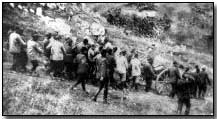Battles - The Capture of Kut-al-Amara, 1915
 The British capture of
Kut-al-Amara - also known as the Battle of Es Sinn, named after the area in
which it was fought - followed rapidly on the heels of the former's capture of the major
Turkish supply base of Nasiriyeh in July 1915.
The British capture of
Kut-al-Amara - also known as the Battle of Es Sinn, named after the area in
which it was fought - followed rapidly on the heels of the former's capture of the major
Turkish supply base of Nasiriyeh in July 1915.
The British regional Commander-in-Chief, Sir John Nixon, initially content with securing Nasiriyeh, soon determined that British losses had been sufficiently light to merit a continued advance to Kut.
In order to persuade the Indian and British governments of the need to continue the advance he argued that Turk forces were forming in concentration at Kut, and that its capture would remove the need to garrison Nasiriyeh. The Indian government readily concurred; the government in London with greater reluctance.
Thus Sir Charles Townshend was instructed to proceed with his 6th (Poona) Indian Division along with a cavalry brigade to take Kut. Townshend, mindful that Nixon's ultimate aim was the capture of Baghdad - for all that Nixon forbore to discuss this with either Indian or British government officials - recommended that six months of supplies be assembled at Amara before the advance began. Nixon disagreed, allowing just six weeks.
Meanwhile the Turks, comprising some 10,500 men, had entrenched themselves under the command of General Nur-ud-Din on both banks of the River Tigris.
 In the event
the capture of Kut did not pose
Townshend any great difficulty. Having successfully crossed the river his
force attacked from the north on 28 September 1915.
In the event
the capture of Kut did not pose
Townshend any great difficulty. Having successfully crossed the river his
force attacked from the north on 28 September 1915.
The Turks were thoroughly routed, losing approximately 5,300 men together with all their guns.
A subsequent fall in the water level somewhat delayed Townshend's advance, enabling the bulk of the remaining Turkish force to escape and retire to prepared positions at Ctesiphon.
Townshend, who was becoming ever more uncomfortable at the ongoing British advance in the face of increasing supply shortages, was nevertheless ordered by Nixon to advance towards Ctesiphon.
The attempt to capture Ctesiphon proved one advance too many for the British, and triggered a humiliating retreat amid a reversal of fortunes for the Turks.
Click here to view a map charting operations in Mesopotamia through to 1917.
Photographs courtesy of Photos of the Great War website
"Toc Emmas" was slang for trench mortars.
- Did you know?
